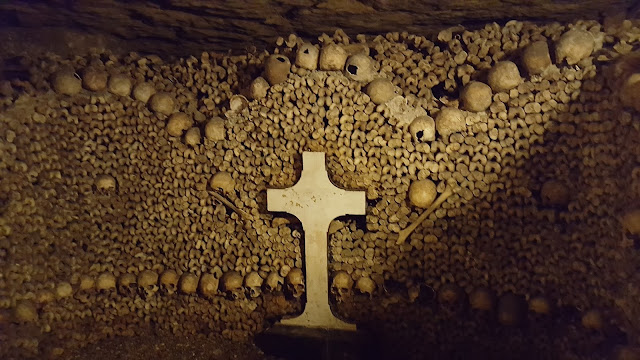Catacombs
I knew one of the sites I wanted to see were the Catacombs of France. I had seen a special on them a long time ago, and with my love of LesMiserable, the interest was peaked, even though he goes into the sewers, not the catacombs.
The mines created a tunnel work under the city of Paris. They mined the rock for their buildings from these mines. Limestone used to build Notre Dame, Louvre, and city fortifications. It was when they were talking about the mines that they referred to Paris once being called, Lutetia. This was the Galio-Roman name.
They started placing the remains in these tunnels created by the mines because space became so limited and disease was becoming a fatal factor.
The metro stop the entrance is located for tourists is Denfert. You can imagine how badly we crushed that word when referring to it! This area is located south of the former city gate called Barrier d'Enfer referred as the Gate of Hell.
They started placing the remains in these tunnels created by the mines because space became so limited and disease was becoming a fatal factor.
The metro stop the entrance is located for tourists is Denfert. You can imagine how badly we crushed that word when referring to it! This area is located south of the former city gate called Barrier d'Enfer referred as the Gate of Hell.
I forget what these numbers meant, I think 1781 was when the particular bones in this area were relocated. The other numbers, I believe, refer to where they were dislocated from.
Our first look into the tunnels after descending over 200 steps.
The black line on the ceiling was put these to give the miners directions on how to get out.
Our first encounter with the bones. Only a portion of this maze of tunnels is open to the
public. When it was decided to make this a place for tourists, many of the bones were
arranged, femur and skulls, to form walls. The catacombs in Paris hold the remains of over six million people in a small part of the ancient mines of Paris.
The Fountain of Lethe, later renamed the Fountain of the Samaritan, was discovered by quarry workers at the end of the eighteenth century and was restored around 1810 when remains began to be laid here. "Sicut Unda Dies Nostri Fluxerun" is engraved above the door that enters this area.

Throughout the burial sites, there were many plaques engraved with Scriptures.
This was the tallest area in the tunnels. I forget what this pillar is to represent.
But in the ceiling above, one can see the layers of the earth.
And this was the way we exited the tunnels!
Now on to the Arc de Triomphe to celebrate France's victory!!
Information from catacomb website and tour information.


























No comments:
Post a Comment